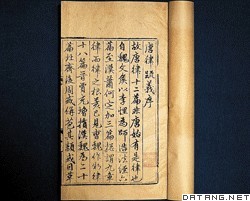1) Tang code


唐律
1.
On the Reasons for Deformation of Tang Code by Koryo Code——From the Perspective of the Relationship Between "Chinesezation" and "Local Customs"
高丽律对唐律变形之原因探析——以“华化”与“土俗”之关系为视角
2.
Tang code stands for the most top level of legislation of ancient China.


《唐律》代表了中国古代立法的最高水准。
2) Tang law


唐律
1.
Comparison Research on Ancient Rome Law and Tang Law Related Good Faith Stipulation;


古罗马法和唐律有关诚信规定之比较
2.
There were seventy seven clauses in Tang law whose law relation subject directly originated from the consanguinity relation,touching upon the Tang Dynasty s administration,civil,marriage,family,inheritance,criminal,lawsuit and so on.
唐律直接以血缘关系主体作为法律关系主体的条文有 77条 ,涉及唐代行政、民事、婚姻、家庭、继承、刑事、诉讼等各个方面 ;其他法律关系主体如凡人、奴婢、良人、皇帝等也是以血缘为依据确定的 ,因此唐律的血缘主义特征是比较明显的。
3.
In the Tang Dynasty, the punishment of banishment was improved considerably, and all the aspects of its implementation were stipulated in details in“the Tang law d.
到唐代时,制定了被后世称为法律蓝本的《唐律疏议》,其对实施流刑的各个方面进行了详细的规定,使得流刑在很大程度上得到了完善;并且,唐代历史资料丰富,其中也不乏对流放之刑的记载。
3) the Tang Code


唐律
1.
Intertextual Theory and Its Implications to English Translation of Ancient Chinese Legal Texts——A Case Study of the Tang Code;
互文性理论与中国古典法律英译的契合——以《唐律》为个案研究
5) The Law of Tang Dynasty


唐律
1.
So it is very important for us to research deep into the law of Tang Dynasty i n order to know the development of criminal laws.
《唐律》是中国古代法律发展史的巅峰。
6) tang lv


唐律
1.
But including "the Tang Lv" the ancient law code all take the ritual as the soul,therefore,relatives hidden to be heavy Special respect, according to the friend or stranger,the high and low decide the right, and emphasis the duty,what protected emphatically was the principles governing relationships between people,but non-dear ones.
而包括《唐律》在内的古代律典皆以“礼”为灵魂,故“亲亲相隐”制度重“别异”、“尚敬”,根据亲疏、尊卑来确定容隐范围及相互之间的权利、义务关系,单纯强调卑幼对尊长的容隐义务,着重保护的是伦常而非亲情。
补充资料:《唐律疏议》
| 《唐律疏议》 中国唐代刑律及其疏注的合编,中国现存最古、最完整的封建刑事法典。30卷。永徽元年(650),唐高宗命长孙无忌、李、于志宁等修《永徽律》,翌年颁行。三年,又令长孙无忌等对《永徽律》的精神实质和律文逐条逐句进行疏证解释,以阐明律条文义,并通过问答形式,剖析内涵,说明疑义,撰成《律疏》30卷,永徽四年颁行。《律疏》与《律》合为一体,统称《永徽律疏》(宋元时称作《故唐律疏议》,明末清初始名《唐律疏议》)。《律》和《疏》具有同等的法律效力。此后《律》文无甚改动,诸帝的增损、编纂多为“令”和“格”、“式”,可谓《唐律》已基本定型。唐朝法典至今只有《唐律疏议》和《唐六典》传世,余均亡佚。《唐律疏议》的律文和疏文反映了唐代社会各阶级、各阶层的法律地位及其相互之间的关系,以及某些政治经济制度,是研究唐代历史的重要文献。《唐律疏议》总结以往各王朝的立法经验及其司法实践,折中损益,使之系统化和周密化。为以后历代刑律的蓝本。《唐律疏议》对古代亚洲各国法典亦产生重大影响。古代日本、朝鲜、越南等国的立法,大都摹仿《唐律》。国际法制史学者将《唐律疏议》与欧洲的《罗马法》相提并论,并视之为古代中国(华)法系的代表著作。现存《唐律疏议》的最古刊本,有上海图书馆藏宋刻本残卷,北京图书馆藏宋刻残本等。敦煌吐鲁番出土文书中有唐写本《律疏》残卷 。在日本也藏有文化二年(1805)官版本等多种古写本、刻本。1983年中华书局出版了刘俊文校点的《唐律疏议》。宋刊本不附《律疏》的《唐律》,也已经由上海古籍出版社影印出版。
|
说明:补充资料仅用于学习参考,请勿用于其它任何用途。
参考词条
